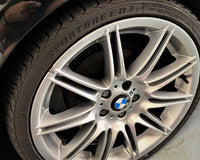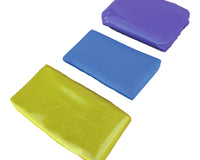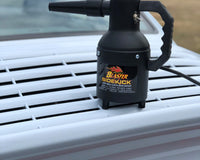When it comes to protecting and enhancing the appearance of a car’s paintwork, car wax and paint sealant are two of the most popular products. Both play a crucial role in maintaining a vehicle's aesthetics and shielding it from external elements. However, these two products differ significantly in composition, performance, and application. Understanding the nuances between car wax and paint sealant will help car enthusiasts and owners make informed choices tailored to their specific needs.
What Is Car Wax?
Car wax has been a staple in car detailing for decades, renowned for its ability to deliver a warm, glossy finish to a vehicle's paint.
Car wax is typically made from natural ingredients, the most notable being carnauba wax, derived from the leaves of the carnauba palm tree. Other components may include beeswax, natural oils, and polymers, blended to create a product that enhances the shine of a car's paintwork. Its organic nature is one of its most distinguishing features.
The primary purpose of car wax is to provide a thin protective layer over the vehicle’s clear coat. It shields the paint from environmental factors such as UV rays, rain, and minor contaminants while amplifying its depth and gloss. The finish achieved with car wax is often described as "rich" and "wet," making it a favourite among classic car owners and enthusiasts.
What Is Paint Sealant?
Paint sealant is a relatively modern product compared to traditional wax, designed to provide advanced and long-lasting protection.
Unlike wax, paint sealant is synthetic. It’s composed of man-made polymers and resins engineered to bond with a car's paint at a molecular level. This chemical formulation makes it more durable and resilient than natural wax.
The key function of paint sealant is to create a robust protective barrier that can withstand harsher conditions and last longer than car wax. Its finish tends to be sleek and glossy, albeit less "warm" than that of wax. This quality often appeals to those who prioritise longevity and practicality over aesthetics.
The Application Process
While the application process for both products shares some similarities, there are notable differences that should be considered to achieve the best results.
Car wax is typically applied in thin layers using an applicator pad. After spreading it evenly across the surface, it is left to haze for a few minutes before being buffed off with a clean microfiber towel. Waxing is often regarded as a labour of love, as the process requires precision and patience to achieve that sought-after glossy finish. It’s a practice many car enthusiasts enjoy as part of their detailing routine.

Applying paint sealant is also straightforward, but the product's synthetic nature means it can be slightly easier to use. Most paint sealants come in liquid form, making them easier to spread evenly. Like wax, sealant should be applied in a thin layer, allowed to cure, and then buffed off to reveal the protective coating. The curing process for sealants is slightly longer, as the product needs time to bond effectively with the paint.
Durability: Wax vs Paint Sealant
Durability is one of the most significant differences between wax and sealant, and it’s often a deciding factor for car owners when choosing between the two.
Car wax, being a natural product, offers relatively short-lived protection. On average, a layer of wax will last anywhere from four to six weeks, depending on the climate and driving conditions. Factors such as exposure to rain, washing frequency, and sunlight can degrade the wax layer, requiring regular reapplication.
In contrast, paint sealant is known for its durability. Thanks to its synthetic formula, sealant can last anywhere from six months to a year, making it a low-maintenance option for those who want long-term protection. This extended lifespan is particularly advantageous for cars subjected to harsh weather or frequent use.
Finish and Aesthetic Appeal
The visual finish of a car is a top priority for many detailers, and this is another area where wax and sealant differ.
Car wax is celebrated for its ability to enhance the richness and depth of a car's paint. It brings out the natural tones and creates a warm, reflective glow that many find visually appealing. This characteristic makes wax an excellent choice for show cars, classic vehicles, or any situation where appearance is paramount.
Paint sealant, on the other hand, offers a high-gloss, mirror-like finish that is sleek and polished. While it doesn’t have the same "warmth" as wax, it excels in creating a sharp, reflective look that is ideal for modern cars with metallic or pearlescent finishes.
Environmental Resistance
Both wax and sealant provide protection, but their effectiveness against environmental challenges varies.
Car wax offers a decent level of protection against UV rays, water spots, and light contaminants. However, its natural composition makes it less effective against harsher elements like acid rain, bird droppings, and industrial fallout. It’s best suited for milder climates and vehicles that are kept in garages or under covers.
Paint sealant, with its synthetic properties, provides superior resistance to environmental threats. It effectively repels water, withstands UV exposure, and resists contamination from chemicals and pollutants. This makes it the preferred choice for cars that face extreme conditions or are parked outdoors for extended periods.
Ease of Maintenance
Ease of maintenance is a crucial consideration, particularly for those who want their car to look good without frequent upkeep.
Car wax requires more frequent reapplication due to its shorter lifespan. This means regular waxing sessions are necessary to maintain its protective and aesthetic benefits. For some, this upkeep is part of the joy of car care; for others, it can be a time-consuming commitment.
Paint sealant, on the other hand, offers a "set-it-and-forget-it" approach. Once applied, it requires minimal maintenance, making it an attractive option for busy car owners. Occasional washing and a quick top-up with a spray sealant can keep the car looking pristine for months.
Cost Considerations
The cost of detailing products can vary significantly, and choosing between wax and sealant often comes down to budget and priorities.
Car wax, particularly premium blends containing high-grade carnauba, can be expensive. However, since it’s sold in small quantities and lasts for multiple applications, the initial investment can be justified for those who value its aesthetic benefits.
Paint sealant tends to be more cost-effective in the long run due to its durability. A single application can provide months of protection, reducing the need for frequent reapplications and making it a practical choice for budget-conscious detailers.
Can You Use Both?
One common question among car enthusiasts is whether wax and sealant can be used together. The answer is a resounding yes.
Using both products allows you to combine their strengths. Apply the paint sealant first to create a durable protective layer, and then top it with car wax to enhance the visual appeal. This combination delivers the best of both worlds: long-lasting protection and a stunning finish.
Conclusion
Choosing between car wax and paint sealant ultimately depends on your needs, preferences, and the level of maintenance you’re willing to commit to. Wax is perfect for those who prioritise aesthetics and enjoy the ritual of detailing, while sealant is ideal for individuals seeking durable, low-maintenance protection. By understanding the differences between these two products, you can make informed decisions that ensure your car remains protected and visually stunning for years to come.




